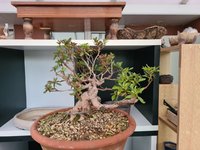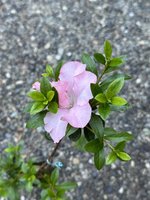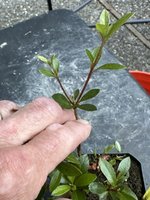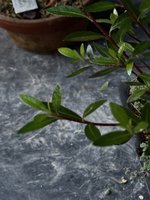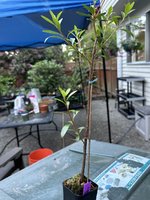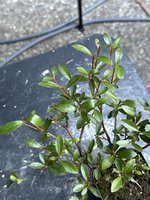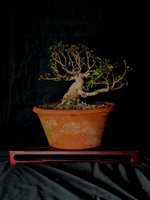Across the tree…….
Leaf clusters and flower sites are basically the same thing.
Let’s go through a few basics… just for future information… note there are quite a number of variations and seasonal issues, but won’t go into those.
Here’s a flowers site complete with 5 branchlets. Note healthy, strong flowers can have even more branchlets, weak flowers have less. Some Satsuki like Nikko, can have multiple flowers on one localized area. These have many, many branchlets in the same area. Same basic principles apply.
Here are the basic post flowering pruning strategies. All can be used at once on the same tree if needed.
First there is no pruning at all. This causes the tree to strengthen overall.
Top View of flower site showing branchlets.
View attachment 551811
Side view.
View attachment 551812
Flower removed, three branchlets removed. The big ones, smallest, leaving two well placed branchlets
View attachment 551813
Looking at another flowering site with the flower removed. Three branchlets
View attachment 551814
Down to two branchlets
View attachment 551815
Down to two leaves for each branchlet. This method is for trees in the building phase and for young trees.
View attachment 551819
Here’s a common issue. The remaining branchlets are of different sizes.
View attachment 551816
Cut to two on the shortest, cut the stem to equal size. Still for building phase. The bare branchlet will sprout leaves in most cultivars. Btw if both are are cut back to just the stems. this is a bulking out, branch building procedure
View attachment 551817
There is also cutting to the cluster of leaves just below the flower site… (this is the base where the branchlets come from). This is used to maintain shape… can cause back budding.
View attachment 551824
“Stopping the growth”. aka cutting the branch tip. Stops growth strengthens shoot.
Before. and. After.
View attachment 551826 View attachment 551827
Finally Cutting to bare wood. Used to prevent a tree from aging and spur back budding.
Some cultivars resent this.
View attachment 551825
Some cultivars will abandon a branch, especially if all the other branches are strong with foliage.
Yet if all branches are pruned hard to leaf clusters or bare stems and a few to bare wood, usually back budding will occur all over the branch.
If all are cutback, especially in spring, often all branches will backbud and restart the tree.
Might want to copy this and save for future reference.
Hope this helps
Cheers
DSD sends



